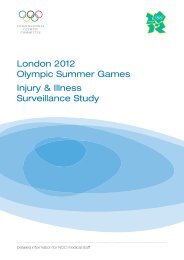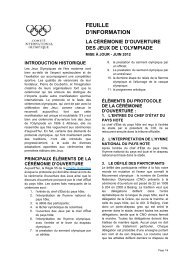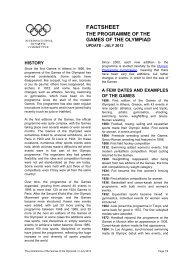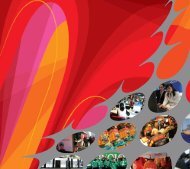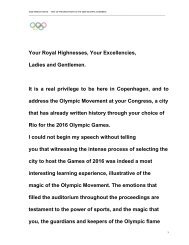8th WORLD CONFERENCE ON SPORT AND THE ENVIRONMENT
8th WORLD CONFERENCE ON SPORT AND THE ENVIRONMENT
8th WORLD CONFERENCE ON SPORT AND THE ENVIRONMENT
You also want an ePaper? Increase the reach of your titles
YUMPU automatically turns print PDFs into web optimized ePapers that Google loves.
4.6. Innovative Sports Facilities: Turning Green to Gold<br />
<strong>8th</strong> World Conference on Sport and the Environment<br />
International Cooperation and Development Department<br />
Report<br />
Mr Roger Bayley,<br />
Design Manager, Millennium Water (Olympic and Paralympic Village<br />
Vancouver); Principal, Merrick Architecture Ltd., Canada<br />
Mr Bayley was one of the primary architects on the Vancouver Olympic and Paralympic Village<br />
and as such focused his presentation on the sustainable development of the village located in<br />
Southeast False Creek. He began his discussion on the threat of climate change and how sports<br />
facility construction is a contributor to greenhouse gas emissions. Having recognised this intrinsic<br />
responsibility Mr Bayley examined the host of new clean and sustainable technologies that were<br />
utilised for the Vancouver Olympic Village. The integration of a tangible sense of community was<br />
evident within the Village as it infused European architectural elements as well as clean technologies<br />
which ranged from water reclamation projects to cooling ponds to improve ventilation. All of these<br />
changes are designed to help shift what a consumer desires and internalise the green conscious<br />
mentality.<br />
Mr Enrico Carbone,<br />
Member, IOC Sport and Environment Commission, architect, Italy<br />
Mr Carbone, having participated directly with the Olympic Commission for the Turin Games,<br />
offered expertise in the area of constructing sports facilities to minimise environmental impact<br />
and leave a lasting legacy. Mr Carbone pointed out that environmentally sustainable construction<br />
will not have universal standards applicable across every location. Rather, sports facilities must<br />
be designed fl exibly and account for the individual nuances which exist in different geographic<br />
areas. Mr Carbone stated that there were seven main considerations for designing sports facilities<br />
in a way which is compatible with the environment:<br />
1) Territorial – If a sports facility is not necessary than it will not be seen as compatible.<br />
2) Financial – If the cost-benefi t analysis is negative then the facility will not be compatible with<br />
sustainability goals.<br />
3) Management – If a facility cannot be managed easily to maximise usage then it will not be<br />
compatible.<br />
4) Nature of Sports – Some sports will not require a facility if interaction with the natural environment<br />
is successfully utilised.<br />
5) Existing Facilities – Before new facilities are constructed, developers should look to see if old<br />
facilities can be modifi ed for the events. New technologies can be grafted onto old sports<br />
facilities and offset the environmental impact of new construction.<br />
6) New Facilities – To the degree that new facilities are used, they should be designed to maximise<br />
clean technologies and minimise environmental impact.<br />
7) Technologies – Cleaner and more effi cient technologies should be used where applicable. These<br />
technologies should also refl ect long-term sustainability.<br />
8) Full-Life Cycle – Buildings will eventually become unusable so developers should maximise the<br />
ability to recycle materials used for their construction.<br />
Page 34 / 80






